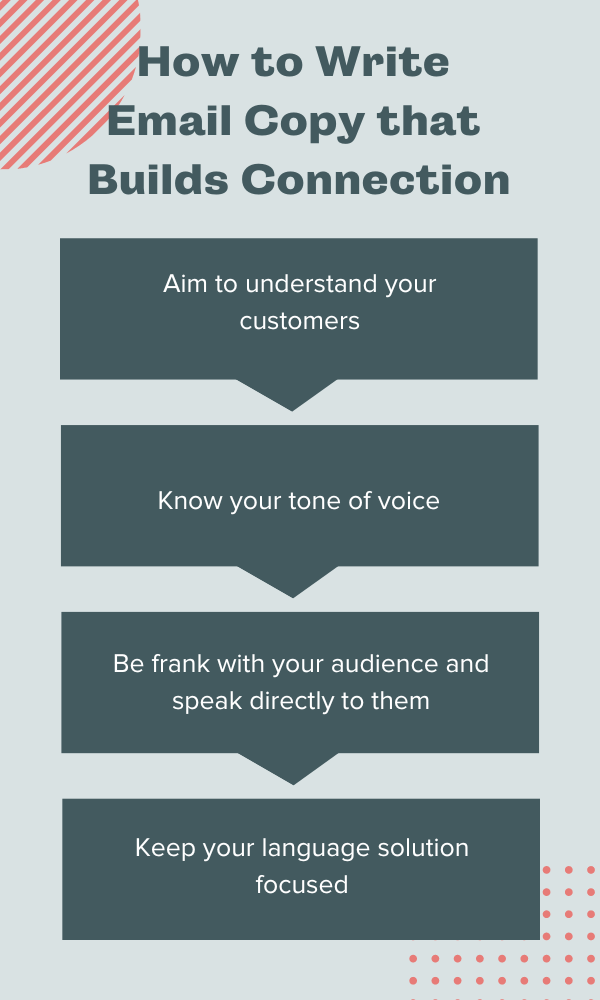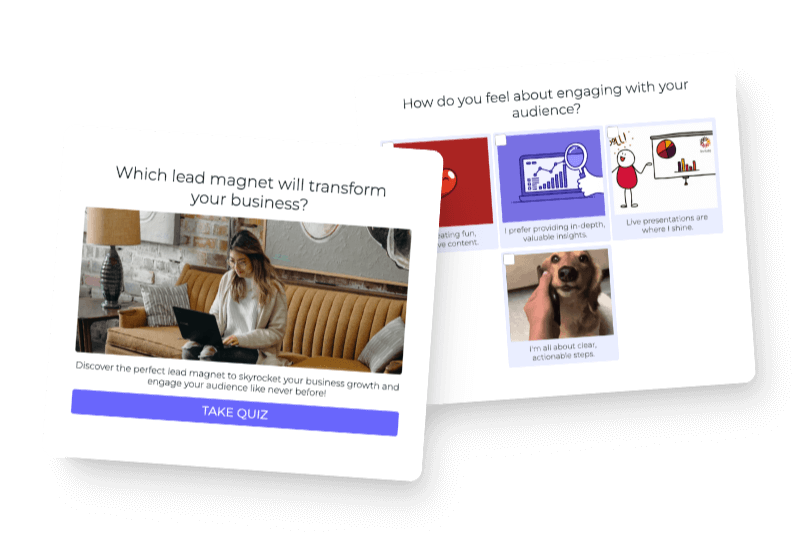One thing’s for sure: we are living in an age of information and we’ve never been more infiltrated with messaging. With content coming at us from every angle, it’s easy to get lost in the noise. So it’s important to keep this in mind, as you think about your email subscribers, and write email copy that builds connection.
Social media can feel like an abyss, and our inboxes can feel like a sea of static.
Even though it’s become easy to mindlessly scroll and consume content endlessly, the desire to be connected is still present. Can you relate to this?
As human beings, it’s in our nature to want to connect. And as a business owner, you probably see the value of creating authentic connections with your customers and clients.
So how do you ensure your message doesn’t get lost in the noise?
This is where the power of emotional connection comes into play. This article will dive into the key components of compelling copy that truly resonates with your audience. Let’s get to it.
Table of contents:
- Why emotional connection?
- Aim to understand your customers
- Know your tone
- Keep it conversational
- Be frank with your audience
- Stay solution-focused
Why is emotional connection important for email copy that builds connection?
As humans, we thrive on emotional connection. Studies show that people who feel understood have greater life satisfaction and show fewer physical symptoms daily.
Put simply, emotional connection drives decision-making. Potential customers will be much more likely to purchase your product when they feel seen and heard by you. Your audience doesn’t want to feel like they’re just another number. This is why you need to find a point of connection from a place of empathy in your marketing strategy.
Empathy-based marketing allows you to see through the eyes of your target audience. It puts you directly in your potential client’s shoes and helps you understand their motivations, challenges, hopes, and dreams.
So how does any of this relate to your email copy? Well, the fact that someone has already subscribed to your list proves they feel connected to you. They’re ready to listen to what you have to say, which is a prime opportunity to build trust and relationships through your messaging.
Email marketing is more personal than other forms of marketing (ie: social media), as it allows you to send the right message to the right people at the right time. Knowing this, fine-tune your copy to send the right message while showing your customers that you’re genuinely invested in their journey. Let’s take a look at how to do just that!

Aim to understand your customers before you write email copy that builds connection
At the core of Interact’s values lies the belief that our success depends entirely on our customers. It’s important to understand customers’ needs, desires, and pain points so that they can be further supported by refining our platform and services.
This applies to you and your business as well—or any other business looking to build authentic connections and create community.
And how you do that is simple: aim to understand your customers!
Your paying customers (or, in this case, your subscribers) will always be your greatest asset when it comes to refining your brand’s messaging. They are, after all, the ones coming to you with a problem to solve.
So how do you better understand your audience? Ask lots of questions. Asking questions speaks volumes to your potential clients and customers. It shows them that you are actively listening and invested in supporting them in their journey.
Consider asking direct questions in your email copy. Questions that:
- Are specific and intentional
- Are curious and empathetic
- Ask “why” in some way
- Give subscribers a chance to share how they feel
In addition to asking good questions in your email copy, be ready and willing to listen to your audience! Give them a clear call to action to respond to you so you can build real dialogue with them, further building that “know, like, trust.”
Know your tone
You know the old saying: It’s not what you say; it’s how you say it. Well, the same rule applies when writing copy that will connect you to your audience.
There are two defining aspects of your email copy. The first is your actual message (which is what you’re trying to communicate), and the second is how you send that message.
Your tone is the voice behind your message. It breathes life into your copy and makes your message come alive. Almost anyone can write a bunch of words to convey a message, but it’s a different story when those words work hard and create an authentic connection with the reader.
So how do you create that tone?
First off, you have to know who you’re trying to reach. Who is your target audience, and what tone will resonate with them? You can say the same thing in many ways, which is why when you know who you’re speaking to, you’re able to position yourself powerfully in your copy.
For example, if your customer base is made up of business professionals between the ages of 40 – 55, you might speak differently to them than if your target audience were primarily Gen Zs looking to become content creators.
The point is that knowing your audience will inform the tone of your copy. And that could mean your message is witty, funny, formal, romantic, or nerdy. You just don’t want it to be boring or way off base from what could captivate your audience.
The bottom line is that using the correct tone will help engage your audience. It will improve the chances that they’ll associate positively with your business or brand. People want to feel something, and how you position yourself with your writing will help you inspire that in your audience.
Be conversational when you write email copy that builds connection
When someone subscribes to your list, they’re telling you they’re interested in what you have to say. It’s like the flirting stage of dating—someone has expressed interest and is curious about what is to come.
Now, imagine you’re in that flirting stage in real life. You ask someone out, but when you arrive, you hit them with the most formal, put-together, slicked-back version of you. It would probably come as quite a shock and put some serious pressure on that person, right?
The same happens when you send an email to your subscribers that wreaks of formality. Remember, email marketing is one of the most personable and intimate ways to connect with your audience. If you really want to build the embers of that connection, keep it conversational!
One of the easiest and most effective ways to build human connection is to . . . act like a human! Write your copy how you would chat to a friend. Tell personal stories and be animated; write informatively, but casually enough that you don’t create a sterile environment.
And most importantly, avoid using passive language and overly formal language. In passive language, the subject comes after the verb rather than before it. Here’s an example: “My trip to Europe is one I will always remember” vs. “I will always remember my trip to Europe.” The second sentence is more direct and conversational.
Makes sense, right? Here are some other handy tips to keep in your back pocket when creating conversational copy that connects to your audience:
- Speak directly to your audience. Avoid using generalizations like “society” or “we,” instead speaking from an “I” perspective while referring to your audience as “you.”
- Use conjunctions. Shorten your copy by saying “you’re” rather than “you are.” Conjunctions make copy feel relatable and a lot less formal.
- Keep it simple! The shorter the sentence, the better. If it helps, read a sentence out loud. You’ll know right away if it’s shaping up to be a run-on sentence.
- Show emotion. Formal copy is often emotionless. Don’t hold back when trying to establish a real-life connection with your readers! When you’re expressive and show emotion, readers will be engaged.
Be frank with your audience
Be frank with your audience! There’s nothing worse than trying to make a big purchase only to have the salesperson beat around the bush, leaving you to fill in the blanks and guess your way into making a decision. Not an empowering feeling.
The same happens when you write email copy that beats around the proverbial bush. Building connection through your writing means talking to your audience, not at them.
In this case, it’s best to keep it simple and honest. Your customers and subscribers will likely place a higher value on authenticity than, well, just about anything. Speak to your audience exactly how you would speak to someone directly in front of you. Say what you mean and don’t hold back, leaving readers to hunt for answers themselves.
Use complete sentences that are short and to the point. Your readers will thank you for it! When you’re honest, transparent, and to the point, the odds increase that your customers will trust you. They’ll know you’re not just trying to sell them something; they’ll feel more connected to you.
Stay solution-focused
Finally, one of the most important ways to build real connection with your audience is by giving them a real solution.
Your customers are coming to you with a problem. They’re showing you a challenge or frustration they’re faced with and giving you an opportunity to make it right!
If you really want to build trust and connect with your customers through your copy, keep your language solution-focused.
Provide readers with relevant and helpful information that will help them overcome their challenges and pain points. Instead of pointing out the negative or coming from a place of critique, identify the problem at hand and provide a clear, realistic solution.
When your language is solution-focused, your audience will see your business or brand as one they can turn to and trust. They’ll identify you as a safe entity they can lean on for support and valuable information.
Conclusion
By keeping emotional connection at the forefront of your email messaging, you’ll build a list full of high-potential leads that convert to dream clients and customers. First, understanding why emotional connection is important for your business is the key to unlocking how you can aim to understand your customers by asking the right questions. Then when you write email copy that builds connection, you’ll just need to know your tone of voice, keep it conversational, be frank with your audience, and stay solution-focused! True emotional connection is a major building block to creating lasting relationships with customers who want to hear from you.
